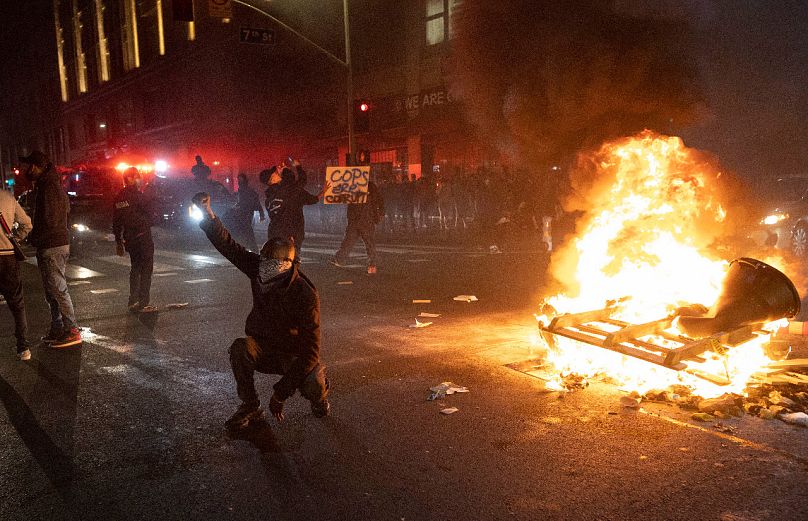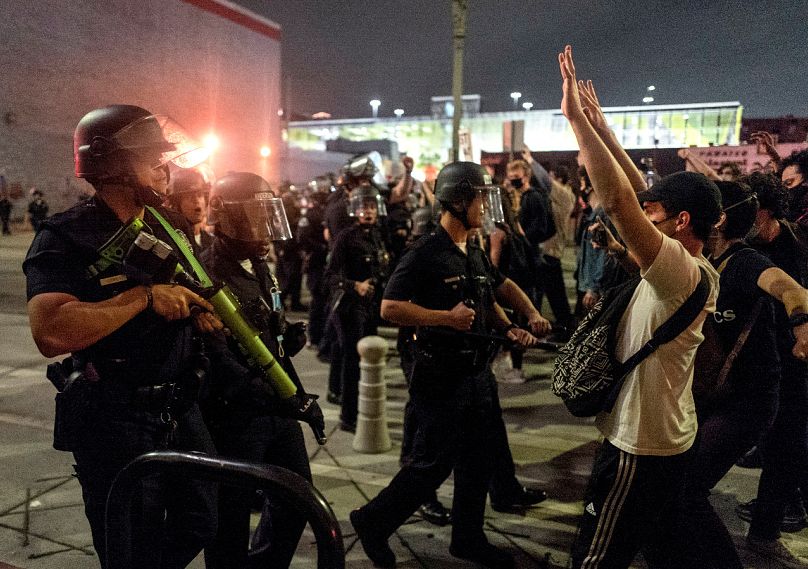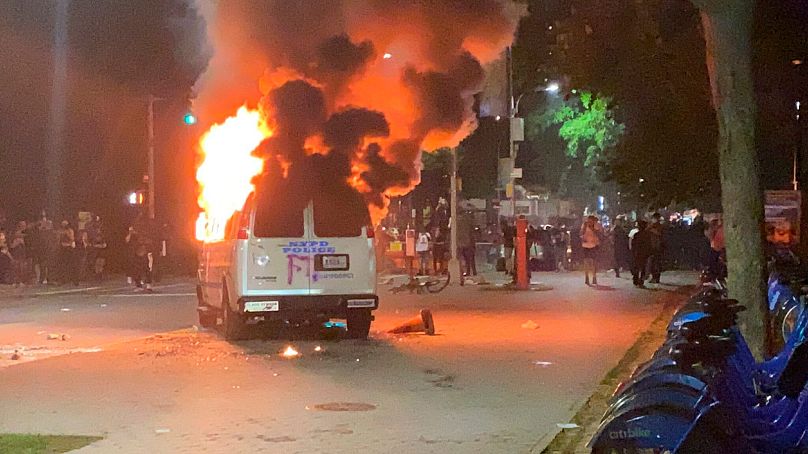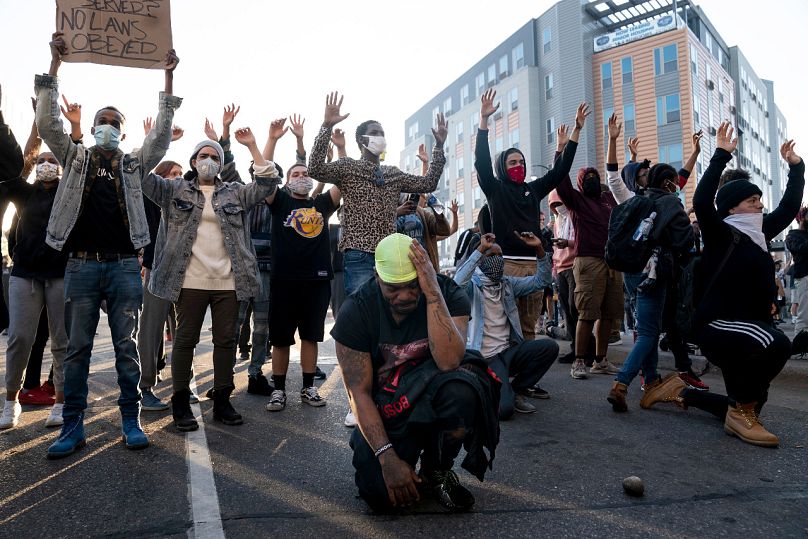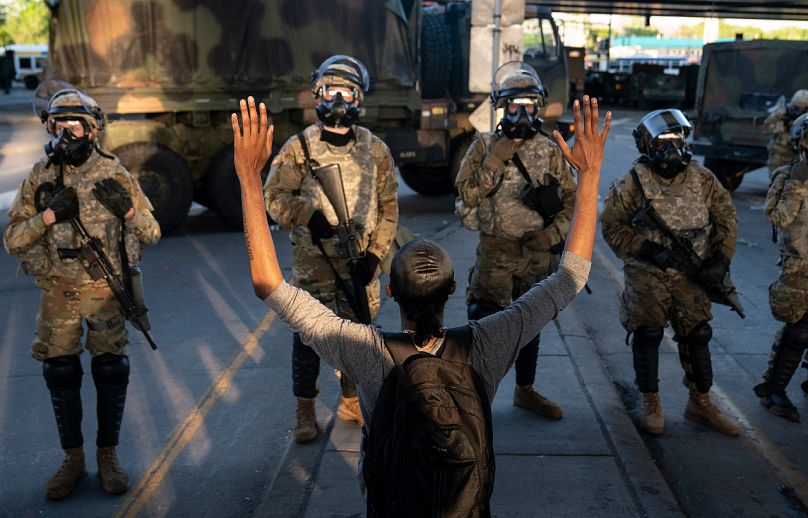Protests and riots have flared overnight in cities across the US even though a Minneapolis police officer has been charged with murder over the killing of black American man.
This article describes events on Saturday (May 30). Click here for the latest overnight on Saturday into Sunday.
The governor of Minnesota said he plans to fully mobilize the state’s National Guard and promised a massive show of force to help quell civil unrest following days of protests over the police killing of George Floyd.
Walz said he was aiming at mobilising more than 1,000 more Guard members, for a total of 1,700, and was considering the potential offer of federal military police.
But he warned that even that might not be enough, saying he expected another difficult night on Saturday.
Walz blamed much of the destruction in Minneapolis on well-organized, out-of-state instigators whose goal was to “destabilize civil society.”
Minnesota Public Safety Commissioner John Harrington vowed a stronger police presence and a change in tactics “because this is intolerable and we are coming to stop it.”
US President Donald Trump urged Minnesota officials to get "tougher" and "honour the memory of George Floyd" as he spoke at a press conference in Washington on Saturday before heading to Cape Canaveral for the SpaceX rocket launch.
There had been appeals for calm after protests turned into riots overnight in cities across the US, over the killing of the 46-year-old black American man at the hands of police officers in Minneapolis.
The unrest came in defiance of curfews and despite the fact that a police officer has been charged with murder over George Floyd's death -- the latest in a series of deaths of African-Americans in confrontations with police.
Demonstrators marched, stopped traffic and in some cases lashed out at police in dozens of American cities. Violent clashes took place in cities including New York, Los Angeles, Atlanta, Chicago, Dallas and Houston. One person was reportedly killed amid unrest in Detroit.
Many protests began as peaceful demonstrations against police brutality and racial discrimination before violence flared. In some places shootings were reported as the trouble continued. Agitators have been blamed amid widespread appeals for calm.
Minneapolis Mayor Jacob Frey urged protesters to stop the violence as he gave a press briefing on Saturday (May 30).
"This is no longer about verbal expression. This is about violence and we need to make sure that it stops," he said.
The White House was briefly locked down with President Trump after demonstrators in Washington DC tried to break through security barriers outside.
George Floyd died after a white officer pressed a knee into his neck for nearly nine minutes while taking him into custody in Minnesota. One police officer, Derek Chauvin, has been charged with third-degree murder and manslaughter, but others who were at the scene remain free. All have been fired from their jobs.
500 National Guard troops have been ordered by Minnesota's State Governor Tim Walz into Minneapolis, St Paul, and surrounding communities. The Pentagon took the rare step of ordering the Army to put several active-duty US military police units on the ready to deploy to Minneapolis.
Walz described the situation as "incredibly dangerous" and Minneapolis Mayor Jacob Frey told citizens there was "no honour in burning down your city" as firefighters tackled multiple blazes into Saturday morning. Violent clashes continued overnight as thousands ignored a curfew to protest.
An initially peaceful demonstration in New York City spiralled into chaos as night fell, as protesters skirmished with officers, destroyed police vehicles and set fires. Video posted to social media showed New York City officers using batons and shoving protesters down as they took people into custody and cleared streets.
Protests in downtown Los Angeles turned violent after night fell. Demonstrators on the West Coast blocked highways in Los Angeles and Oakland.
In Detroit one person was killed after someone in an SUV fired shots into a crowd of protesters near the city’s Greektown entertainment district, according to reports quoting police.
In Houston, where George Floyd grew up, several thousand people rallied in front of City Hall.
Atlanta has witnessed what was described as the worst violence of the week. Georgia’s governor declared a state of emergency to activate up to 500 members of the state National Guard "to protect people & property in Atlanta". CNN's headquarters was attacked with damage reported.
Atlanta Mayor Keisha Lance Bottoms condemned the violence. “This is not in the spirit of Martin Luther King, Jr.," she implored the protesters to no avail. “You are disgracing the life of George Floyd and every other person who has been killed in this country.” Another impassioned plea for calm came from rapper Killer Mike, and from Martin Luther King's daughter Bernice King who called for non-violent protest.
Attacks on police buildings or vehicles have also been reported in other cities including Portland, Oregon; Richmond, Virginia; Oakland and San Jose, California.
In Brooklyn, New York, the names of black people killed by police, including Floyd and Eric Garner, who died on Staten Island in 2014, were on signs carried by those in the crowd, and in their chants.
Protesters gathered outside the White House, with Donald Trump inside, and some tried to push through security barriers along Pennsylvania Avenue.
There's been anger at the President's response to the violence in Minneapolis, after he tweeted: "When the looting starts, the shooting starts". It was later flagged by Twitter as violating rules against "glorifying violence", which the White House denied.
Joe Biden lamented the “open wound” of the nation's systemic racism on Friday as he responded to the police killing of George Floyd.
“The original sin of this country still stains our nation today,” the presumptive Democratic presidential nominee said. "It’s time for us to take a hard look at uncomfortable truths.”
George Floyd died on Monday after police were called to a grocery store where he was suspected of trying to pass a counterfeit $20 bill.
Before the violence flared overnight on Friday, protests across the United States were largely peaceful. Thousands chanted “No justice, no peace” and “Say his name. George Floyd”. They hoisted signs reading: “He said I can’t breathe. Justice for George”.
In Houston, where George Floyd grew up, demonstrators included 19-year-old Jimmy Ohaz, who came from the nearby city of Richmond, Texas. “My question is how many more, how many more? I just want to live in a future where we all live in harmony and we’re not oppressed,” he said.
The issues of race inequality and police brutality have come to the fore at a time when the US is being battered by the coronavirus pandemic which has brought the worst economic crisis for decades.
The number of black people killed by police in America is disproportionately high compared to white people, as illustrated by Washington Post analysis. The phenomenon is not new but has been highlighted by social media in recent years, with several cases being filmed by members of the public.
Among the most prominent were the deaths of Michael Brown -- which sparked the Ferguson riots in 2014 -- Freddie Gray in Baltimore in 2015, Eric Garner who was the victim of a police chokehold in New York in 2014, and Alton Sterling and Philando Castile -- both shot dead by police within days of each other in 2016.
More recent cases include the deaths of Breonna Taylor, shot by police at her home this year, Dominique Clayton who was killed in Mississippi in 2019, and 12-year-old Tamir Rice who was shot dead in a Cleveland park.












